Production Notes - For Your
Eyes Only
Although "Moonraker" (1979) had been another huge
hit for EON, their biggest in fact since "Diamonds
Are Forever"
(1971), as
the
series headed into its third decade, a rethink was clearly called
for. While "The Spy Who Loved Me" (1977) and "Moonraker" had
been
huge commercial successes, the franchise had gone about as far
as it could in the direction of gadget-laden spectacle. And
critical
notices, particularly for Moonraker, had been far from favourable.
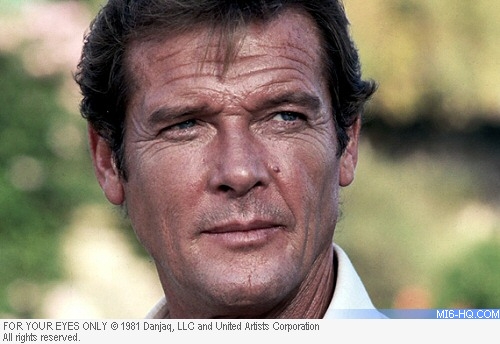
Above: Roger Moore as James Bond
|
Michael
G. Wilson, who had been made an executive producer on
"Moonraker", was having more creative input in the series now
and
felt that the time had come for Bond to be a more human figure,
less reliant on gadgets and toys and, reminiscent of the Connery
Bond, more reliant on his wits. To this end, Wilson was to collaborate
closely with Richard
Maibaum on the new script which took its
title and some of the characters from the short story For
Your Eyes Only, other characters and situations from Risico, another
story from the same collection, and the keel-hauling scene from
Live and Let Die.
But while Maibaum and Wilson knocked the script into shape,
producer Albert Broccoli had a major problem to contend with
- despite his apparent enthusiasm to stay with the series after "The
Spy Who Loved Me", Roger Moore was
now making noises to the contrary. In July 1980, Moore had attended
a press conference for his latest film, "The Sea Wolves",
and it was widely reported that he told the press that he would
no longer be playing Bond.
|
Broccoli set about trying to persuade his star to make
at least one more film and began looking around for a replacement,
just in case. Michael Jayston seemed to be the most likely
candidate at the time and would indeed play Bond - but
not until ten years later when BBC radio did an adaptation
of You Only
Live Twice.
Moore's indecision was to prove a baptism
of fire for John
Glen, a long time series editor and second unit director
who was here making his debut as director. Planning ahead,
he mapped out a pre-credits sequence that would serve
to introduce audiences to the new Bond should it become
necessary - it would feature Bond visiting his wife's
grave with flowers before being menaced by an unnamed
bald man with a white cat... The villain was clearly
meant to be Ernst
Stavro Blofeld, but the ongoing legal situation with Kevin
McClory ensured that the character never be named
or properly seen.
The sequence was to remain in the film, despite Moore's
change of heart. In September, Broccoli and representatives
from United Artists met with Moore and agreed a substantial
increase in the actor's salary. But Moore was to remain
uneasy about the new, tougher Bond he was being asked to
play.
|
|
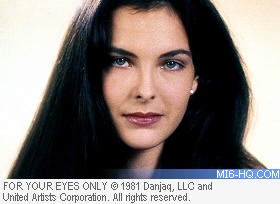
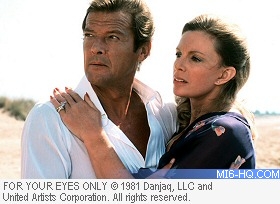
Above: The leading ladies of "For
Your Eyes Only -
Carole Bouquet (top) and Cassandra Harris.
|
It was second time lucky for Moore's co-star Carole
Bouquet.
She had auditioned for the part of Holly Goodhead in "Moonraker",
only to lose out to model-turned-actress Lois
Chiles. This time
she was offered the part of the vengeful Melina Havelock, tracking
down her parents killers armed with a crossbow.
Also luckier this time was Julian
Glover who had been shortlisted
as a potential Bond during the search for a new 007 that took
place prior to "Live And Let Die". Here he appeared on the wrong
side of the law, playing the villainous Kristatos, while Bond's
ally, Columbo, was played by Oscar winner Chaim
Topol.
Lower down the cast list was Cassandra
Harris, an Australian
actress who had been cast as Countess Lisl Von Schlaf. She unwittingly
played a key role in the future of the Bond film series when she
brought her fiance to lunch one day to meet Broccoli - a struggling
young actor named Pierce Brosnan. It was the first time the two
men had met. It wouldn't be the last.
|
Although both Desmond
Llewelyn and Lois
Maxwell were to return in their familiar roles, one
familiar face would be missing this time. By the time
shooting began at Pinewood, Bernard
Lee had been struck down with stomach cancer and
was in the Royal Free Hospital in London. He was to die
there on 16 January 1981. As a mark of respect, all of
M's dialogue was split between Q, the Minister
of Defence (played by Geoffrey Keen) and Bill
Tanner (James Villiers). Tanner had been a regular
character in Fleming's novel, acting as M's chief of
staff and although he made a a brief uncredited appearance in "The Man With The Golden Gun", this would be the first substantial on-screen role for the COS.
On 15 September 1980, the cast and crew began work at
the Villa Sylva at Kanoni in Corfu, the first day of a
five week shoot on the island. The main unit then set off
for Kalambaka on the Greek mainland to shoot in and around
the spectacular monastery that sits on top of a virtually
sheer column of rock. The crew were far from welcome however,
the monks who still lived in the neighbouring monastery
of Meteora taking great exception to the crew's presence.
They complained to EON that Bond's reputation for indiscriminate
sex and violence was an affront to the ancient monastery
and demanded that filming be halted. On 17 October, the
monks closed their monastery to the public and sent letters
of protest to the Greek government and to the head of the
Greek Orthodox Church. They even resorted to hanging their
laundry out of the windows in an attempt to ruin the shots. |
|
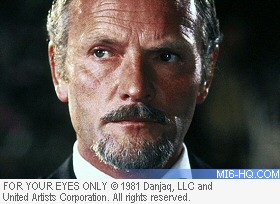
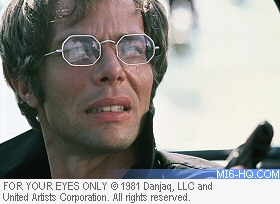 Above:
Julian Glover as the central villain Kristatos (top) and his
cold-blooded assassin Emile
Locque, played by Michael Gothard. Above:
Julian Glover as the central villain Kristatos (top) and his
cold-blooded assassin Emile
Locque, played by Michael Gothard.
|
But filming progressed regardless with Bond veteran Rick Sylvester
(who had performed the parachute jump at the beginning of "The
Spy Who Loved Me") leading his stunt team on the difficult and
dangerous assault on Kristatos' stronghold.
The crew returned to Pinewood at the end of 1980 where Peter
Lamont had been constructing his interior sets. Lamont had been
Ken Adam's art director and had worked on the Bond films since
the exterior of Fort Knox in "Goldfinger" (1964) and later,
"The Man With
the Golden Gun" (1975). His work scaled down the excesses of
Adam's vast interiors and reflected the more down to earth, grittier
feel that Broccoli and Wilson were pursuing.
By the end of January, the main unit was overseas again, in
northern Italy, where they were filming ski scenes in Cortina
d'Ampezzo
in the Dolomite mountains. Glen must have suffered a heart- stopping
moment of deja vu when he arrived on the location and found
the
nightmare of "On Her Majesty's Secret
Service" (1969) repeating
itself all over again - just as the snow had deserted his second
unit
in Muren, Switzerland, so he arrived in Italy to find that unusually
mild conditions leaving him with no choice but to bus in truckloads
of snow from neighbouring areas.
|
But things were going to get a lot worse than that. Shooting
went smoothly enough in Italy until, in February, on the
very day of shooting, tragedy struck. The crew had been
shooting the last scenes of the bobsleigh chase between
Bond and Kriegler's henchmen
when one of the sleighs, driven by stuntman Paolo Rigon,
overturned. The sleigh careered dow the run with Rigon
trapped beneath it. The stuntman died of the injuries he
received during the accident.
A separate underwater unit had been put
together under the supervision of Al Giddings and it spent
some time in
the 007 tank at Pinewood before heading off for the warmer
climes of the Bahamas. It was down to Giddings to help
Glen oversee the keel-hauling scene which had originally
appeared in Fleming's Live and Let Die and which had been
proposed for a number of films. No-one had ever attempted
it, however, due to the difficulties involved in shooting
a sequence that was shot partly underwater and partly on
the surface. Glen said, "It's a scene which no-one
really wanted to shoot, except for Cubby... It was very
difficult to control... It was the highest (cost) of the
Bahaman operation, running something like $2,700 per foot." |
|
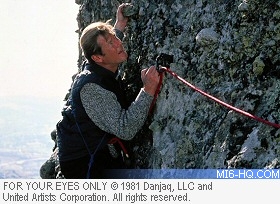
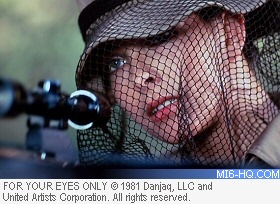
|
As principal photography came to an end, Maurice
Binder set
about creating his main title sequence - but this time he did
something
slightly different and featured the performer of the title song,
Sheena Easton, in the title sequence itself. No other singer
had
thus far appeared on screen. Also appearing in the title sequence
was model Perri Small whose real name, Penelope Smallbone,
would be appropriated
by the crew and used as a character in the next film in the sequence,"Octopussy".
24 June 1981 marked the premiere of "For
Your Eyes Only" at
the Odeon, Leicester Square. It was attended by the Prince of
Wales
and his then fiance Lady Diana Spencer and was held for the benefit
of the Royal Association for Disability and Rehabilitation.
There
were more than a few comments about the apparent insensitivity,
in this context, of the opening scene featuring a madman in
a
wheelchair... Though the film did well enough at the box office
(its worldwide gross reached $195,300,000) but in America, admissions
had slipped to 19.8 million, almost six million down on "Moonraker".